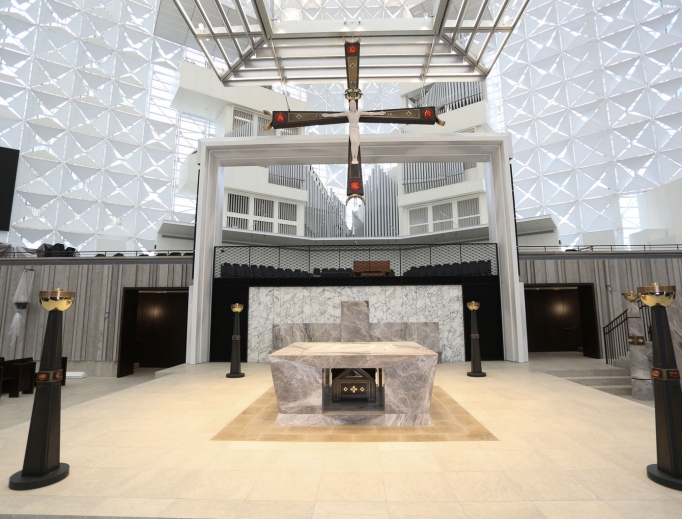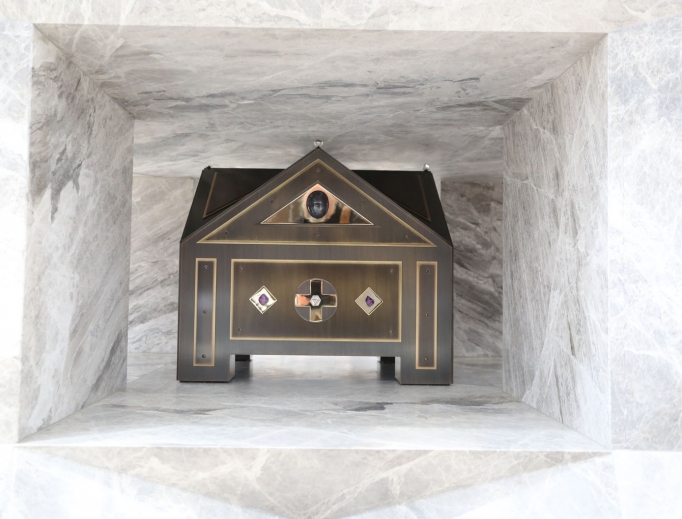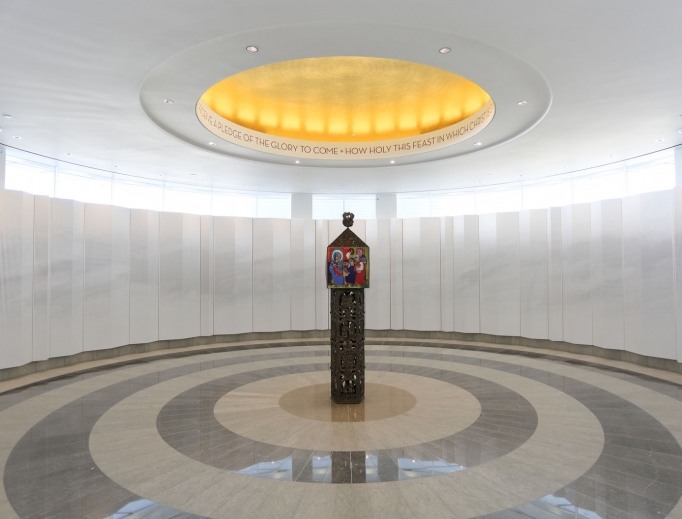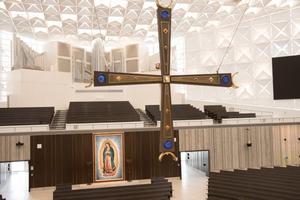From Crystal Cathedral to Catholic Cathedral
COMMENTARY: Very few things are truly unprecedented in the life of the Church, but a Catholic cathedral built inside of a former Protestant church is one of them.

ORANGE, Calif. — What does a cathedral for the 21st century look like? The dedication on July 17 of the new Christ Cathedral in the Diocese of Orange, California, offers one of the most creative answers to that question.
No cathedral has ever been built in the circumstances of Christ Cathedral, and it took an unusual measure of boldness for the diocese to embrace the challenge. The history of Christ Cathedral bears witness to an important part of the Catholic story of our time.
Very few things are truly unprecedented in the life of the Church, but a Catholic cathedral built inside of a former Protestant church is one of them. Christ Cathedral is the former “Crystal Cathedral,” used for decades as the megachurch setting for televangelist Robert Schuller’s Hour of Power.
The building and surrounding campus — 35 acres in Garden Grove, California — were acquired by the Church in 2011, after Schuller’s ministry went into bankruptcy proceedings. It was a historic bargain — a property worth hundreds of millions was purchased for $57 million.
The Diocese of Orange was chosen as the favored buyer — it was not the highest bidder — because it promised to maintain the religious purpose of the site. Additionally, it promised to maintain the exterior structure of the several buildings on the campus, especially the “Crystal Cathedral” itself, the second-most-famous campus in the area. The first is nearby Disneyland.
What should a cathedral look like? For much of U.S. Catholic history, they looked like the great European cathedrals, even as they drew on different parts of that long tradition. Nineteenth and early-20th century projects like St. Patrick’s in New York, St. Paul’s in Minnesota and St. Louis in Missouri are quite different from each other, but all are magnificent examples of the tradition of sacred architecture being successively adapted to the American context. Though not a cathedral, Washington’s massive Basilica of the National Shrine of the Immaculate Conception reaches back to an even earlier Byzantine style, though it includes other elements, as well. It was dedicated in 1959.
The traditional answer is not the only answer. A cathedral can be built using new materials and employing new architectural styles, something that brings sacred meaning to contemporary schools of design. We see that in the design of Liverpool’s Cathedral of Christ the King, completed in 1967, in which a modern design in the round replaced an earlier design that echoed St. Peter’s in Rome.
Another example would be the cathedral of Rio de Janeiro, St. Sebastian, completed in 1979, which is meant to look like the pyramids built by the Mayan civilization. The best known American example is the neighboring cathedral to Orange, the 2002 Cathedral of Our Lady of the Angels in nearby Los Angeles.
Those three examples, and others like them, were not without controversy. The objection was made that they did not “look” like churches. Sacred purpose was not brought to new architectural styles as much as it was swallowed up by them.
California has its history of mission churches dating back to the time of St. Junípero Serra, but in the sprawling suburbs that grew up in the 1960s and 1970s, the Crystal Cathedral, completed in 1982, was God’s house in a television age.
Therefore, Christ Cathedral was a unique project. The exterior “Crystal Cathedral” would remain. What the cathedral would look like from the outside was already settled. The important difference in Orange is that the Crystal Cathedral, the trapezoidal box of 10,000 panes of glass, was in fact what the most famous church looked like.
When Schuller began his ministry, preaching in a drive-in to congregants in their cars, he was in a largely undeveloped area. When he built the Crystal Cathedral, it became an important local landmark, known also around the world as a result of the popularity of the Hour of Power television ministry. It was a building of sacred purpose — “built for Christ,” Schuller said — and it was recognized as a church. The problem of not “looking like a church” did not exist in the unique circumstances of Orange. It was what a church in Orange looked like.
The exterior remained as is, but Christ Cathedral does look significantly different from the outside, at least at night.
In order to cut down on the heat and glare inside what was analogous to a giant greenhouse, some 11,000 “quatrefoils” have been installed as a second, inner wall of the cathedral. The panels, consisting of four triangles that make a square, reflect sunlight outward as well as help with acoustics inside.
The reduction of heat from direct sunlight now makes it affordable to air-condition the cathedral, which was prohibitively expensive before. The effect from inside is to make the exterior shell softer and more textured than the sharp angles and flat surfaces created by panes of glass. From outside, it makes the entire cathedral look like a glowing “box of stars” after the sun goes down.
With the exterior in place, the challenge was how to make Schuller’s church-cum-television studio fitting for Catholic worship. The challenge was “moving from a Word-centered space geared toward televangelism and an entertainment model of worship to a place of sacramentality,” wrote Msgr. Arthur Holquin, a former director of the Office for Worship for the Orange Diocese, who has written an account of the cathedral transformation here.
That challenge was met by changing the two centers of Schuller’s model of worship — preaching and music. The great balcony pulpit is gone in favor of the bishop’s cathedra below, prominent but no longer the dominant focal point. And the frame of the enormous pipe organ — one of the largest in the world — has been painted white; it’s original brown wooden frame made it the visual backdrop of the entire building.
The introduction of the two centers of Catholic worship — the altar and the pulpit (ambo) — has been done in marble. The sharp edges of the stone match the angles of the glass building, but the material itself, used in cathedrals and grand churches the world over, is quintessentially Catholic.



The Crystal Cathedral was so entirely open to the outdoors — harking back to the drive-in preaching days — that there was no place for sacred images: no solid walls to paint, no niches for statues, no stained glass. That was solved by an enormous mosaic of Our Lady of Guadalupe on the lower wall facing the altar and a monumental tapestry of Christ the Pantocrator suspended from the ceiling. The latter might be read as a complement to the imposing Christ in Majesty, which dominates the apse of the National Shrine an entire continent away in Washington.
The $77-million renovation of Christ Cathedral — which included structural work for seismic safety, the cleaning and resealing of all the glass panels, and the restoration of the organ, transported to Italy and back for that purpose — is almost complete. The organ itself will be tuned over the next year, and Christ Cathedral will be fully operational next spring. After the dedication, the cathedral will be closed during the week, but open for Sunday Mass.
Father Raymond J. de Souza is the editor in chief of Convivium magazine.

















